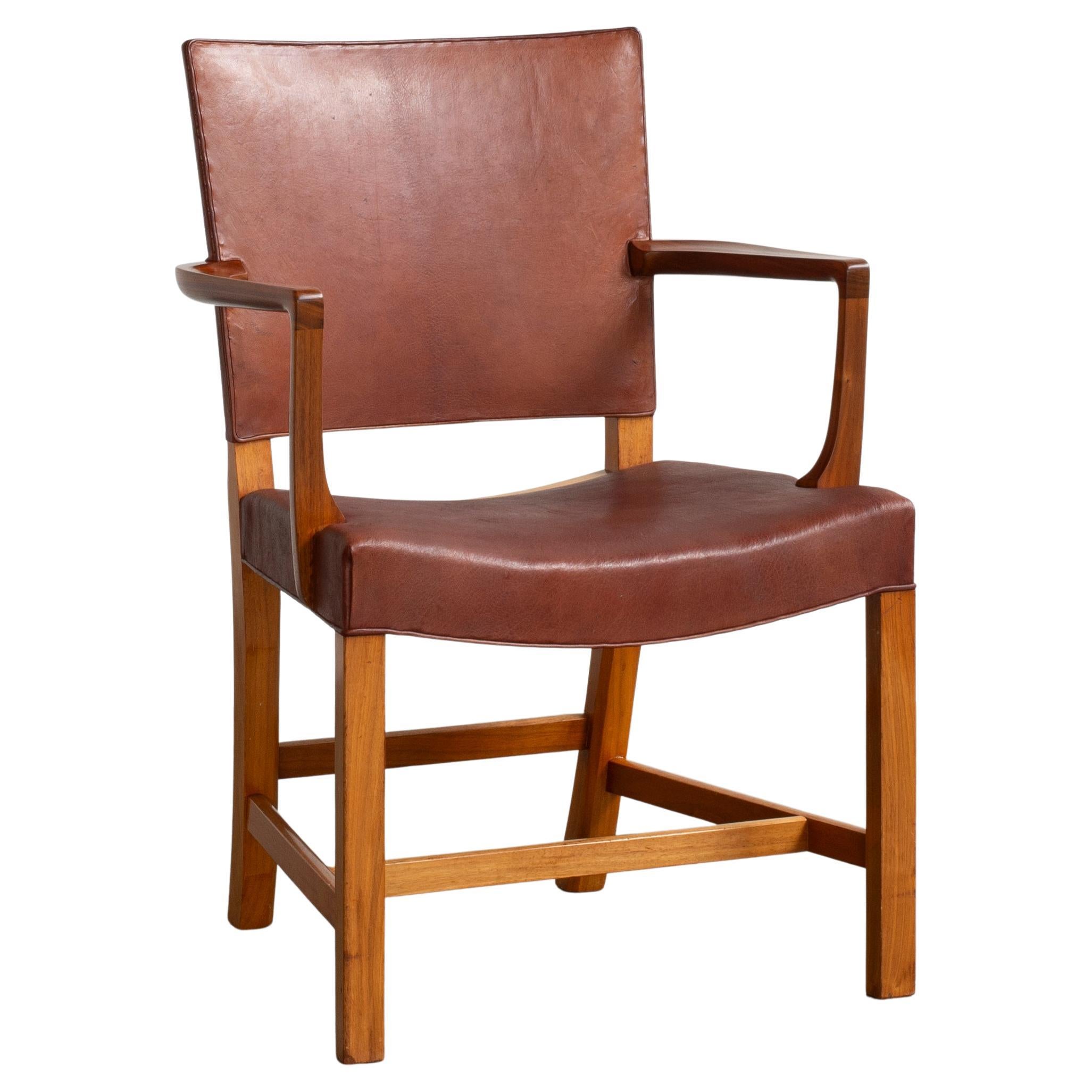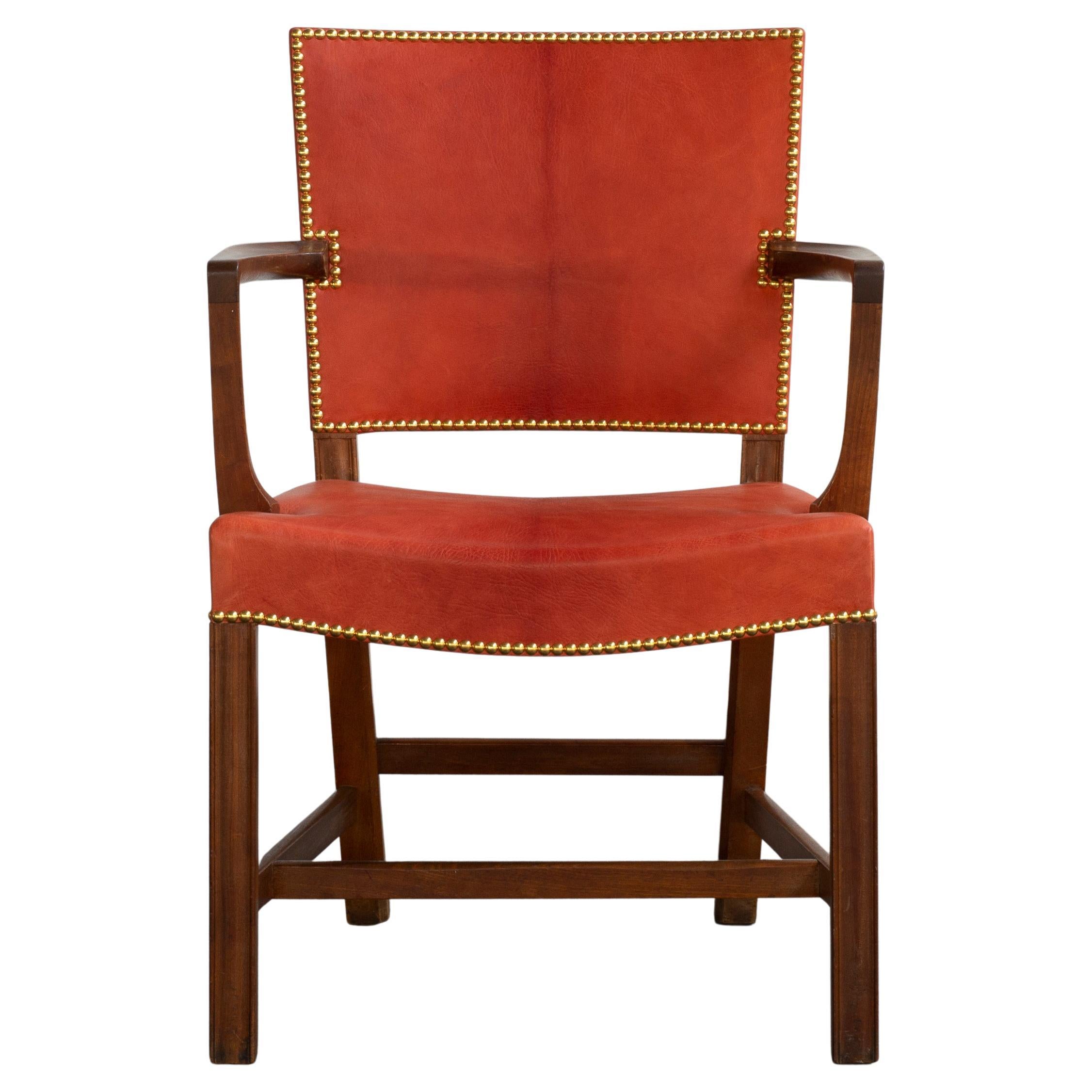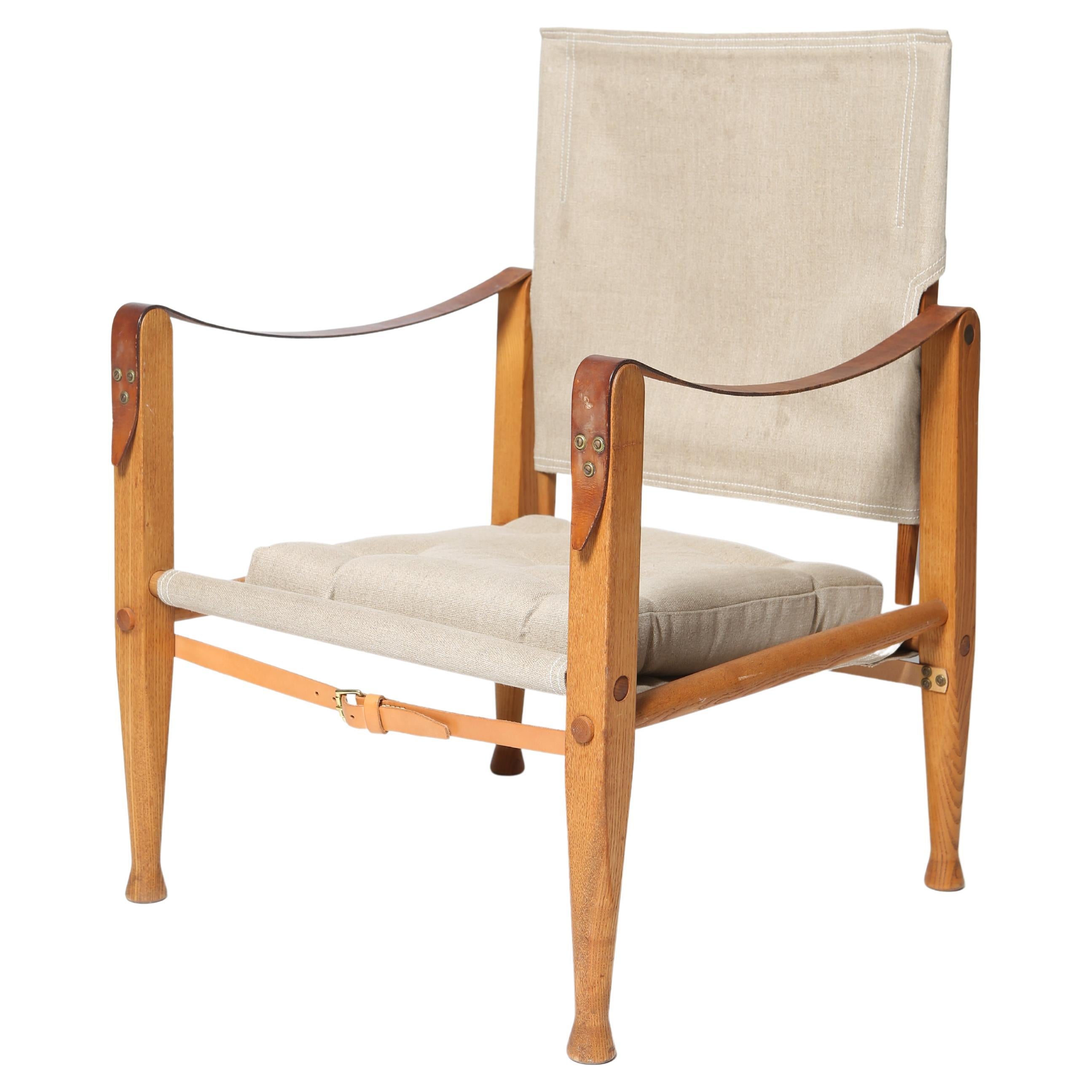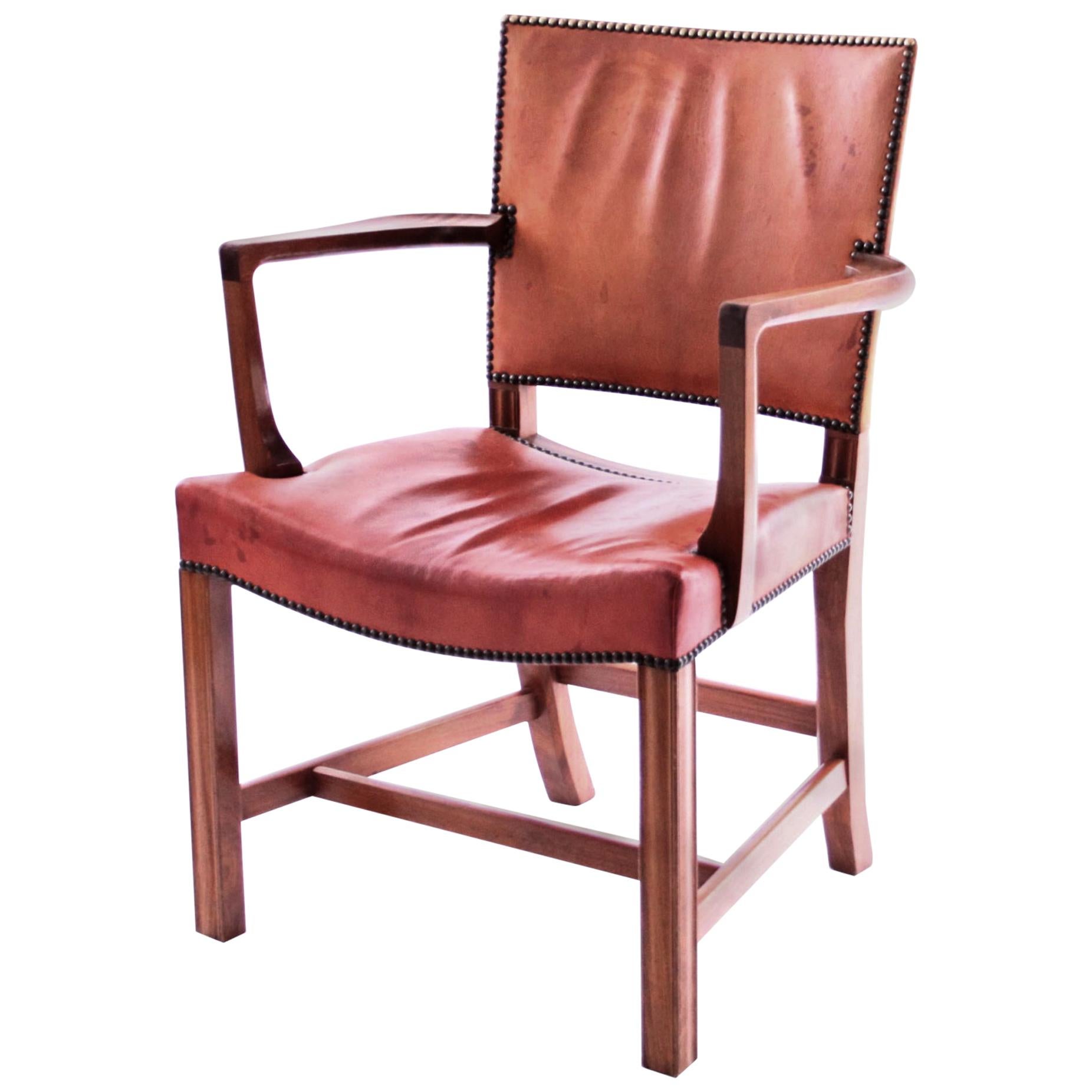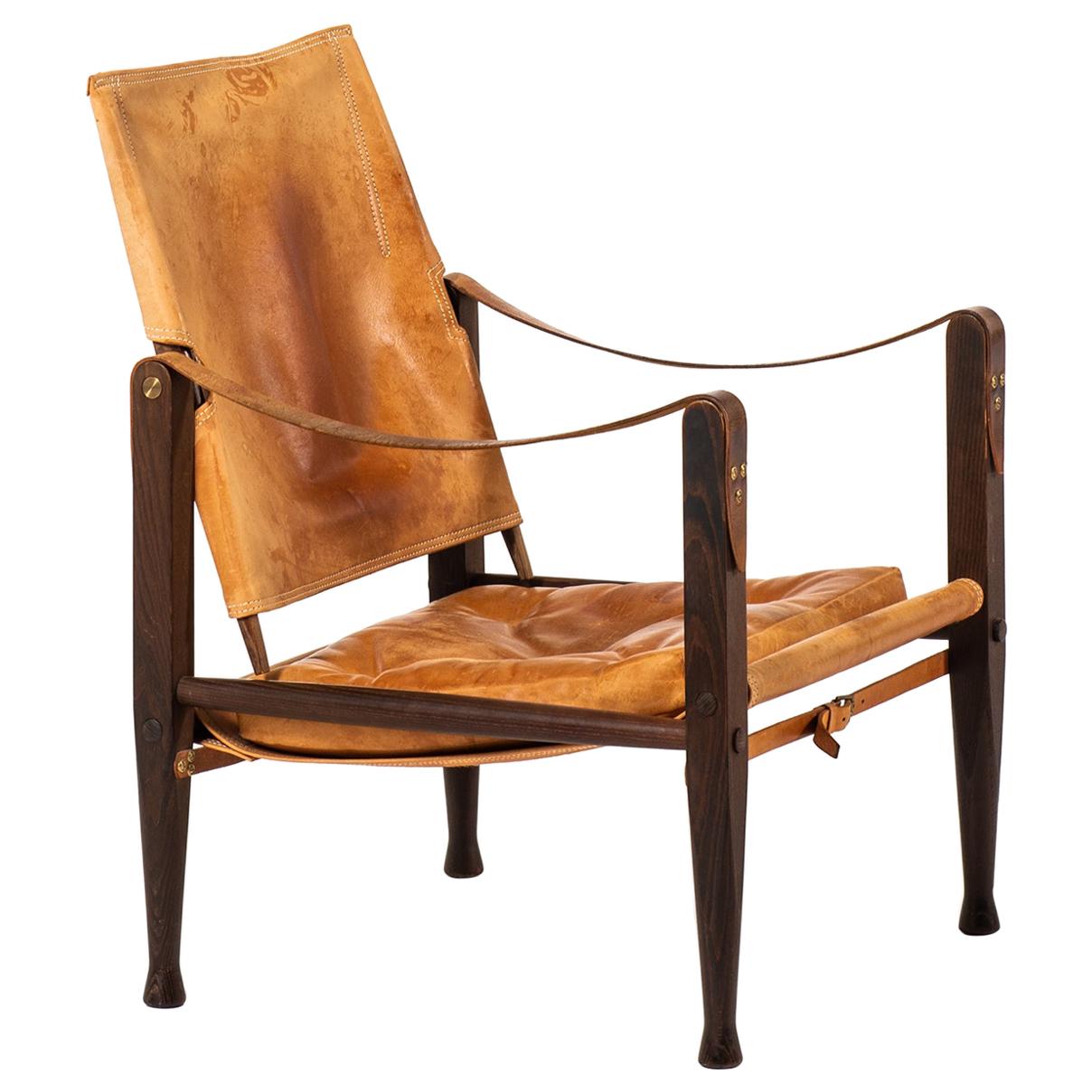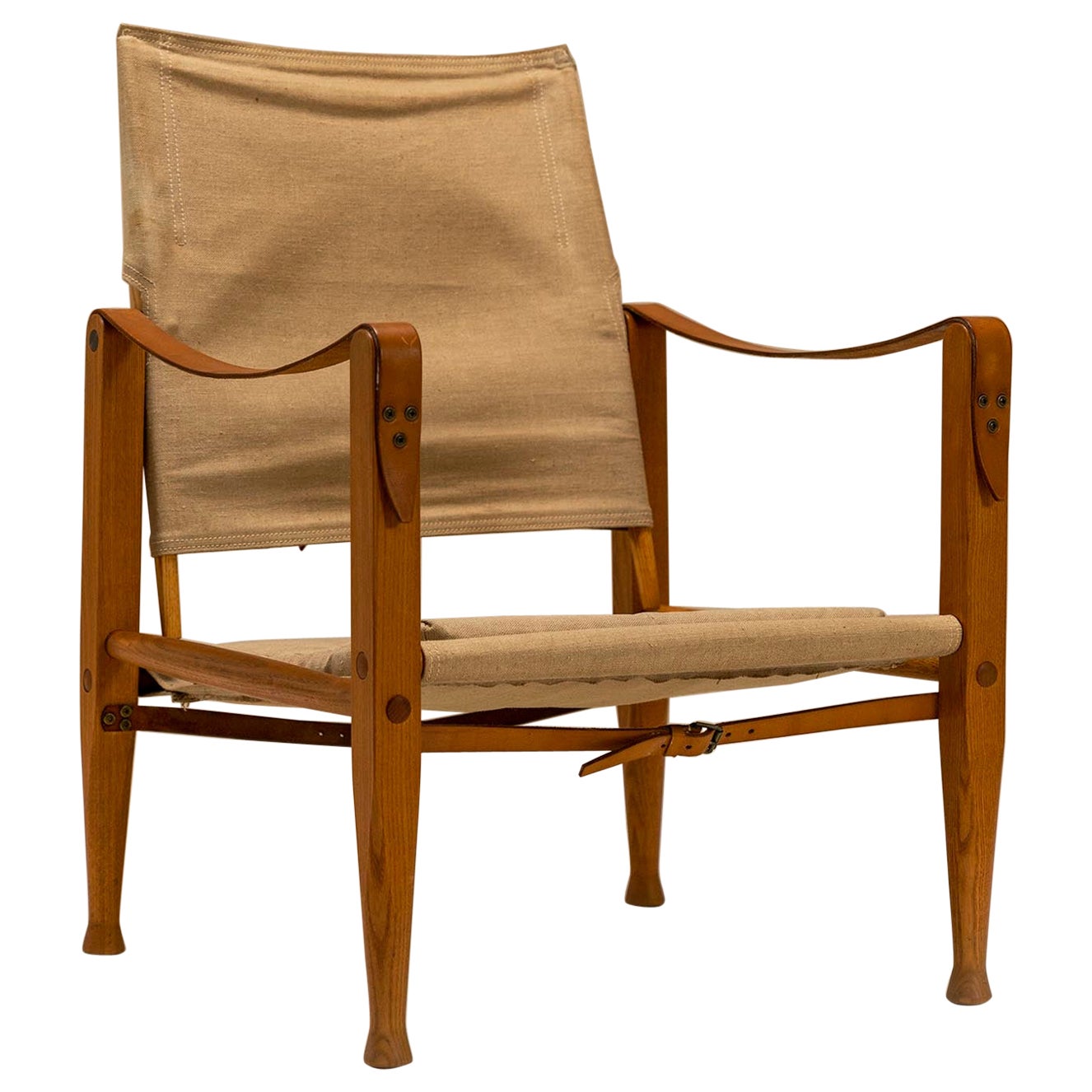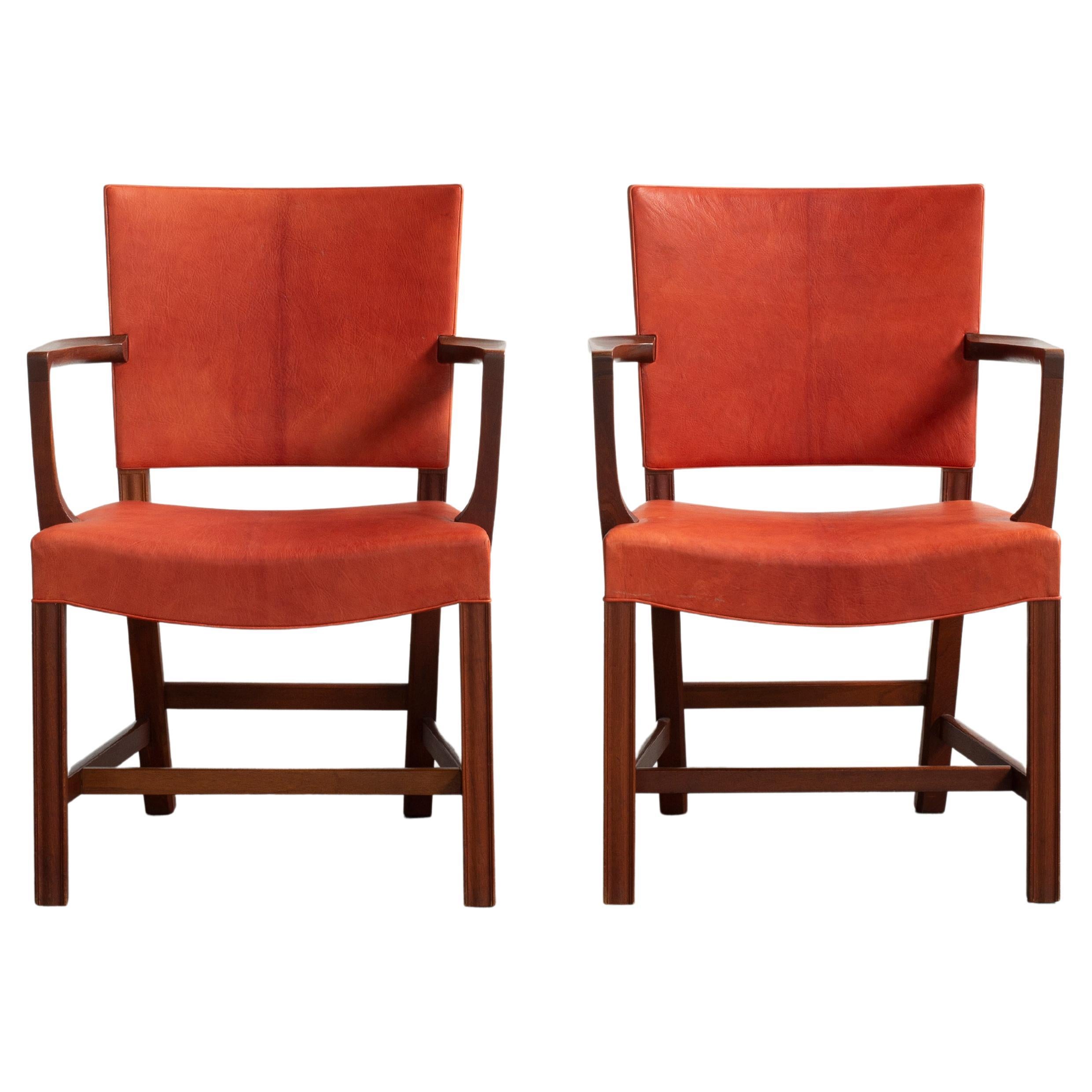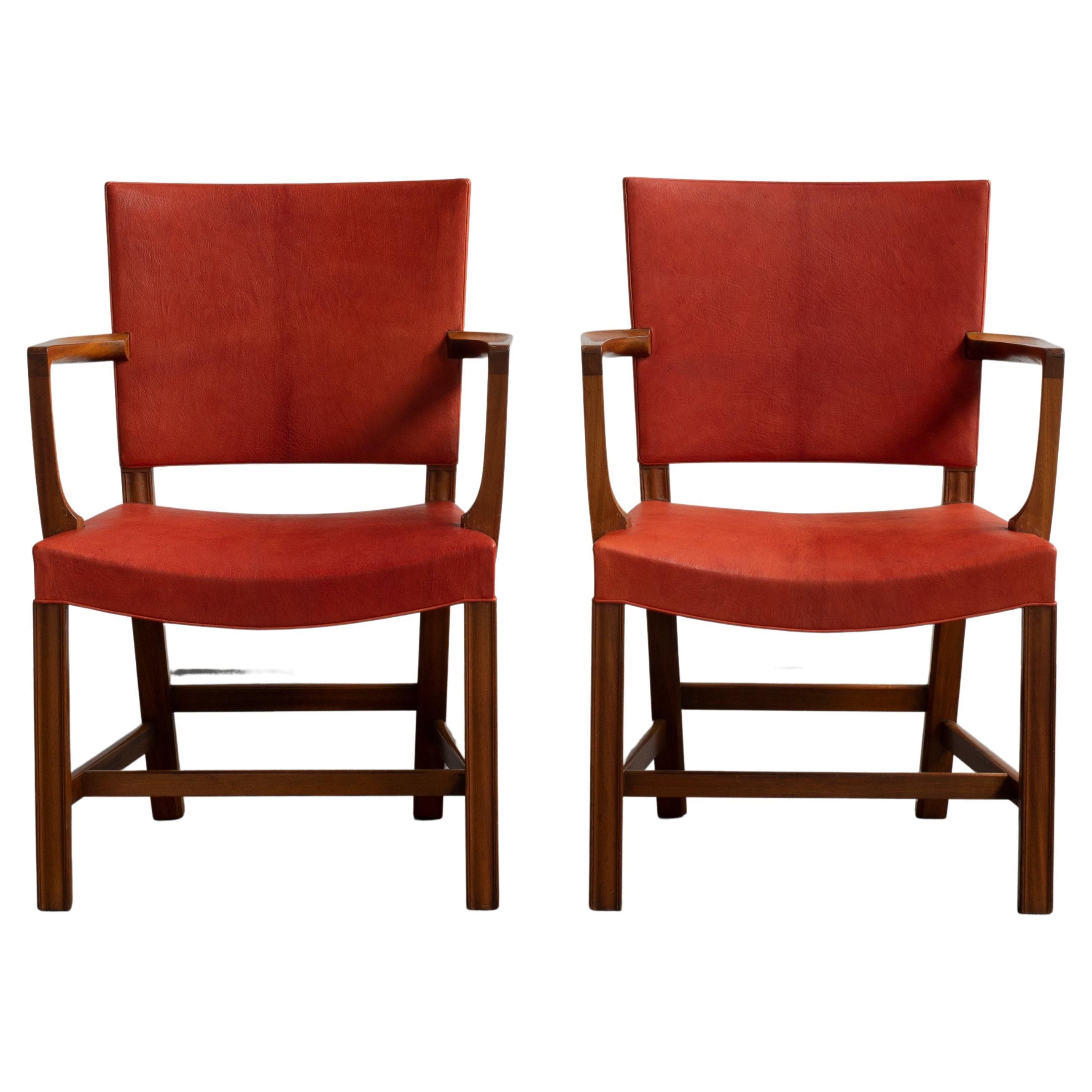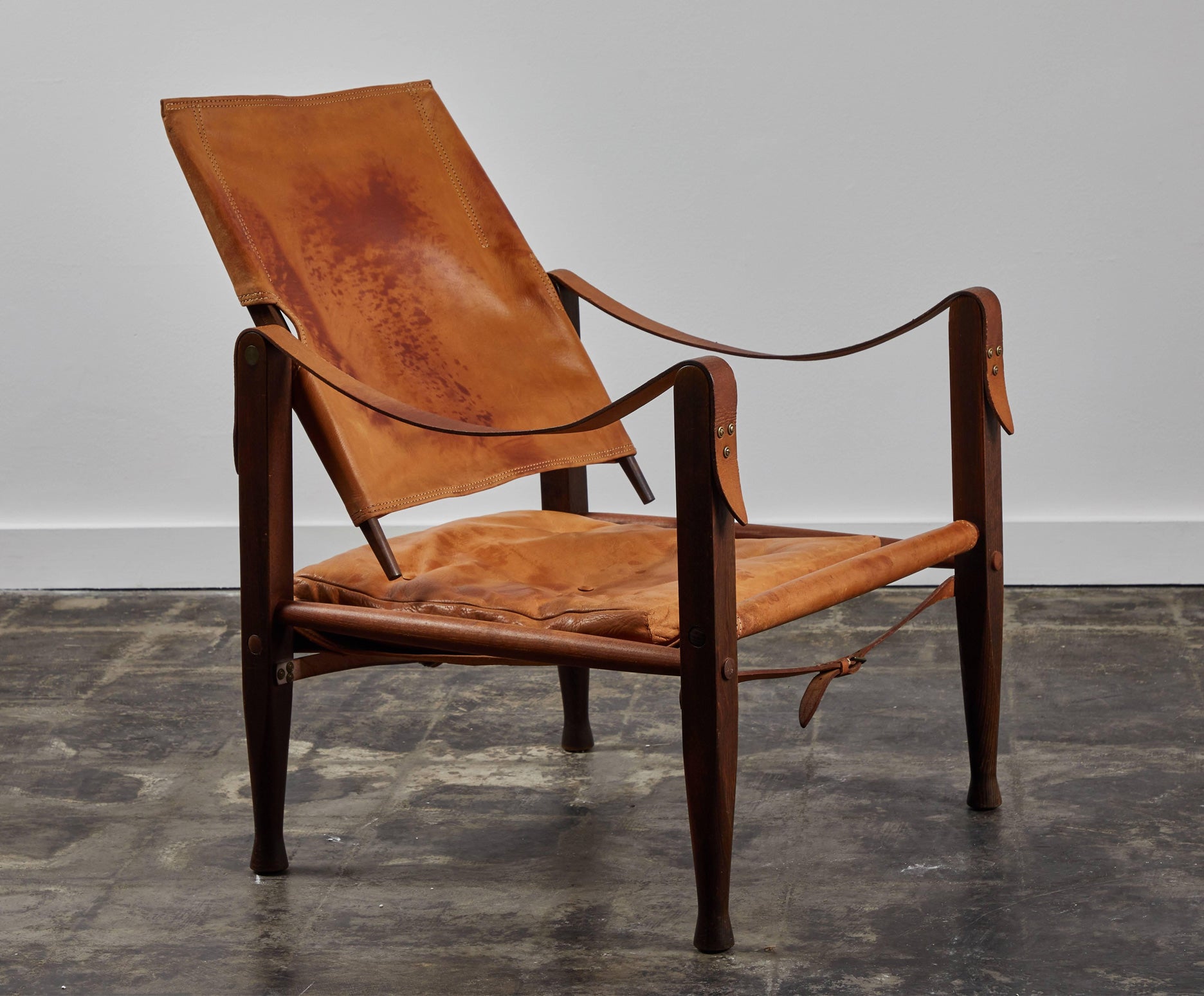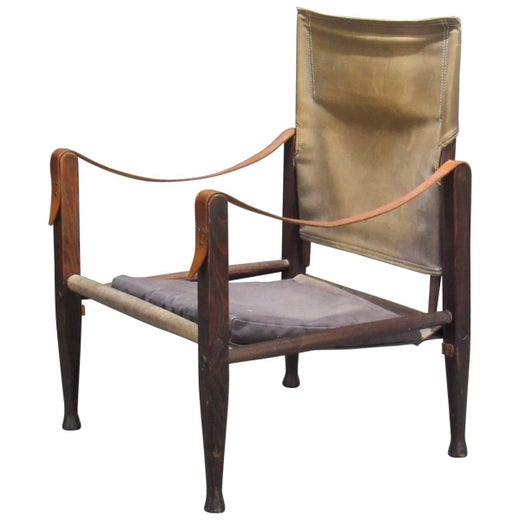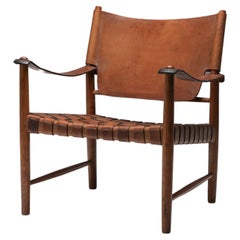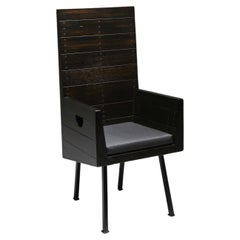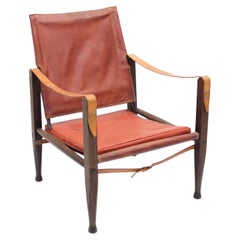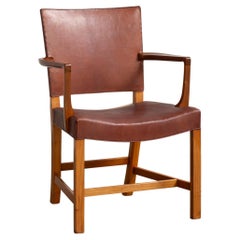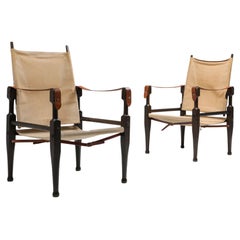
Safari Chairs Designed by Kaare Klint for Rud Rasmussen, Denmark, 1960s
View Similar Items
Safari Chairs Designed by Kaare Klint for Rud Rasmussen, Denmark, 1960s
About the Item
- Creator:Kaare Klint (Designer)
- Design:
- Dimensions:Height: 31.5 in (80 cm)Width: 22.45 in (57 cm)Depth: 22.45 in (57 cm)Seat Height: 14.18 in (36 cm)
- Style:Scandinavian Modern (Of the Period)
- Materials and Techniques:
- Place of Origin:
- Period:
- Date of Manufacture:1950s
- Condition:Wear consistent with age and use. Minor losses.
- Seller Location:Antwerp, BE
- Reference Number:1stDibs: LU933418760122
Safari Chair
The Safari chair, created by legendary Danish designer Kaare Klint (1888–1954) in 1933, has roots in one of the earliest known examples of do-it-yourself furniture. Specific accounts vary, but Klint was inspired by an image of a Roorkhee chair (perhaps spotted in a travel guide) being used on an African safari.
Named for the headquarters of the Indian Army Corps of Engineers in Roorkhee, a city in Northern India, the Roorkhee chair was a military campaign chair that was popular with British officers during World War I. The chair’s maker, who was tasked in the late 19th century with developing lightweight, adaptable seating that could be quickly taken apart for the British military, remains unknown. The Roorkhee’s seat was made of stretched canvas while the armrests were leather straps, and it was probably the design’s practical simplicity that appealed to Klint, who is celebrated for having incorporated rigorous research on precedents, proportions and materials into his designs.
At the time of the Safari chair’s inception, Klint — whose start in design owes to the influence of his father, architect P.V. Jensen Klint, as well as a furniture-making apprenticeship at age 15 — was already playing a prominent role in the trajectory of Danish design. He was a professor at the Royal Danish Academy of Fine Arts in furniture design (a department he founded in 1924), where his students included Hans Wegner, Ole Wanscher and others. Through his own remarkable designs as well as his teaching, Klint became known as the “father of Danish modernism.”
Although Klint’s interpretation of the clever military campaign chair design is the most faithful to the original, other modern chairs based on the Roorkhee include Le Corbusier’s Basculant chair and the Wassily chair designed by Marcel Breuer.
The Safari chair’s flexible structure sees an integration of loose mortise-and-tenon joints that are strengthened when someone sits in it. As compared to vintage versions of the Roorkhee, it’s clear that Klint made important changes in designing his chair, such as an angling of the seat that better supports ergonomics. The chair was originally produced by Rud Rasmussen Snedkerier and exhibited at the Copenhagen Cabinetmakers’ Guild Exhibition in 1933.
Today, the solid wood Safari — made of Danish ash with a canvas or ox-hide seat and saddle-leather armrests — is manufactured by Carl Hansen & Søn. A seat cushion and footstool are available, and like its lightweight 1930s-era prototype, the chair can be assembled and taken apart without the use of tools.
Kaare Klint
Architect, teacher and furniture designer Kaare Klint is among the most important figures in Scandinavian modernism. Widely recognized as the father of modern Danish furniture, Klint sought to pay homage to historical furniture styles and prized functionality as essential to designing for modern living. He established the design school at Copenhagen’s Royal Danish Academy of Fine Arts, and his students became mid-century legends of cabinetry and furniture-making.
Klint prioritized functionalism and drew on an array of influences in his own work. Furniture experts will observe the influence of 18th-century English seating in his Red chair, while Klint’s iconic Safari chair had roots in campaign furniture. The other exemplary chairs, sofas and tables for which he is known bear the mark of Thomas Chippendale and Biedermeier furniture as well as Greek and Roman forms.
Klint's father was Peder Vilhelm Jensen-Klint, a formidable architect of his day. The younger Klint initially followed in his father’s footsteps, studying under him as well as distinguished architect Carl Petersen. Alongside Danish architect Ivar Bentsen, he headed the renovation of the Designmuseum Denmark in Copenhagen from 1920–26 (Klint also furnished the institution as part of the project). Around the same time, Klint helped found the furniture design school at the Royal Danish Academy. The impact of his role as an instructor there cannot be overstated — he mentored such esteemed cabinetmakers and furniture designers as Børge Mogensen, Hans Wegner and Ole Wanscher.
A prominent advocate of ergonomics, Klint valued comfort and functionality over style. Painstaking research went into each piece of sophisticated yet wholly unadorned furniture he designed, as he endeavored to build structures that took into consideration human proportions and scale. And like the Shakers, Klint believed that quality craftsmanship and good materials were integral to the design of durable furniture that was free of embellishment.
The humble grace of Klint’s style characterizes legendary seating designs that continue to charm today’s legions of mid-century modern enthusiasts. His Safari chair, Faaborg chair, Ravenna armchair and Propeller stool — as well as most of the seating created by Danish modernists generally — have warmed interiors and influenced furniture designers all over the world.
Find vintage Kaare Klint furniture and other Scandinavian modern furniture on 1stDibs.
- Arne Noréll Safari Chair, Norell Mobel, Sweden, 1960sBy Arne Norell, Norell Möbel ABLocated in Antwerp, BESirocco Safari chair by Arne Norrél, Sweden, 1960s. Designed by Swedish architect Arne Norell in circa 1962 and made by his own company 'Norell Möbel AB' in Sweden. Frame in solid w...Category
Vintage 1960s Swedish Scandinavian Modern Armchairs
MaterialsLeather, Wood
- Modernist Armchair by Dom Hans van der Laan, Netherlands, 1960sBy Dom Hans van der Laan, Jan de JongLocated in Antwerp, BEDutch modernist chair, Dom Hans Van Der Laan, Jan De Jong, 1961, Bossche School One of 12 ever made, from the boards room of the townhall of Budel, 1961, The Netherlands. It was com...Category
Vintage 1960s Dutch Modern Armchairs
MaterialsCopper
- Rattan Chair by H. Broekhuizen for Rohé Noordwolde, Netherlands, 1960sBy Rohe NoordwoldeLocated in Antwerp, BERohé Noordwolde; Rattan; Chair; Armchair; Herman broekhuizen; Noordwolde; Dutch Design; 1960s; Netherlands; Rattan chair designed by H. Broekhuizen for Rohé Noordwolde in the 1960s....Category
Vintage 1960s Dutch Mid-Century Modern Armchairs
MaterialsMetal
- Madison Dining Chairs by Fred Sandra for De Coene, Belgium, 1960sBy De Coene FrèresLocated in Antwerp, BEFred Sandra's "Up 636" dining chairs from the 1960s as part of the Madison series for De Coene. Crafted with a rich walnut frame, these chairs feature chic...Category
Mid-20th Century Belgian Mid-Century Modern Dining Room Chairs
MaterialsFaux Leather, Walnut
- Functional Art Chair / Throne "'Spring Swab" by Lionel JadotBy Lionel JadotLocated in Antwerp, BECollectible design / Functional art, Lionel Jadot for Everyday Gallery, Belgium 2020 Born in Brussels in 1969, Lionel Jadot is an interior designer, artist, designer, filmmaker, adventurer. But all at once, preferably. Lionel Jadot is firing on all cylinders. ‘I never throw anything, I pick up everything. Not having a green thumb, I’m trying cuttings, weddings against nature. I never forget a line.’ He’s inviting us in subtle, off-beat worlds, on the edge of reality. Its material is made of dilated time. A wandering spirit, he seeks a protective balance in a hostile world. It is his constant questioning: what happens to the place where we live? For Lionel Jadot, everything is object, everything is history. He draws from other places, other times, and seeks what’s linking them. He sews, stitches, unpicks, blends materials, combines eras. He will enshrine some wood essence in metal, some mineral in a plant, the old in the new. ‘I take extra care to the joint between two materials.’ With him, there is always some play in the parts, as in a piece of machinery. From a kingdom to another, he provokes organic, viral growths, generating energy. Linking past and future, he never forgets a line. ‘I accumulate them.’ He’s inviting us in subtle worlds, off-beat, on the edge of reality. Are we in 1930 or in 2030? Both, no doubt. Its material is made of dilated time. The eye goes hand in hand with the ear. ‘When I walk into a place, I listen to the good (or bad) it does to me. An ineffable feeling.’ He recreates mutant buildings, like the future Royal Botanique, a 5 stars hotel housed in the Church of the Gesu, a former convent behind a 1940 façade. He talks about a ‘hotel object’, which he holds and turns around in his hand. A wandering spirit, he’s flirting with retro-futurism. The Jam, another hotel, is intended for urban travelers, fans of swiftness, fluidity and hospitality. He designs interiors as a set of objects: a motorcycle cut in concrete becomes a bar counter. He finds gothic cartoon echoes, from the likes of Moebius, Alejandro Jodorowsky, Enki Bilal, sets from Garage Hermétique and Blade Runner, a protective balance in a hostile world. Discovering Jadot’s little cosmos of collected and accumulated goods, it becomes clear that every element has its own story. I tried to collect them and in turn, devour them in the coming paragraphs. But first: the show is best experienced seated, barring the distinction between object of use and object of attention, they invite for different types of conversation. The seats, chairs, thrones all make us think of our own physical comportment, and of how the seat lends grandeur to the person sitting on it, by crowning its presence. The crackling floor, the felt walls and the diffuse light slow you down into an oddly absorbing environment, in which you are left puzzled. In the eclectic collages of objects, bits and pieces collected all over the world come together in ways practical, and logical, though possibly only in the artist’s mind. All his finds eventually seem to fall into place. Starting with the mere conception of a chair, rather than with a set-out plan or sketch, the works are intuitively construed out of an archive that one can only imagine the dimensions of. Things forgotten by others, precious for him, were all once designed for their own purpose. Here they find their fit as a base, a closing system or a balancing element. The first piece that opens the exhibition, the most throne-like of all seats in the show, builds around a chair of his grandmother, protected by mops, and harassed with bed springs. As you enter the space, you pass by a shell leaning over a yellow seat that stems from his old Mustang, and find a white stool piece with Mexican leather dog training whips— the white building blocks of which turn out to be dried molding material, as found and broken out of a bucket by workers every morning. Further, the stone piece that reminds one of the stone age, is indeed made of 400 million old rocks, and the soft seats are lent from construction, where these strokes of textile carry up the heaviest goods. In the corner — but as you walk this walk please be seated on any of the thrones and experience the work for a moment— the green fluffy cover is made by XXXX who remakes cartographies of warzones, one of which is here mounted on a flexible fishing chair. On an experience level, the conversation chair enhances self-confidence, while putting you literally in a good spot with the person you’re conversing with. The lamp perfectly shows the playful Cadavre Exquis...Category
2010s Belgian International Style Armchairs
MaterialsMetal
- Dom Hans Van Der Laan Chairs, Bossche School, Dutch Design, 1960sBy Dom Hans van der LaanLocated in Antwerp, BEChairs; dining chairs; Bossche School; Dom Hans van der Laan; Jan de Jong; The Netherlands; Dutch Design; 1960s; Minimal Brutalist Style; Six remarkable dining chairs in minimal b...Category
Vintage 1960s Belgian Mid-Century Modern Chairs
MaterialsWood, Pine
- Kaare Klint, Cognac Leather Safari Chair for Rud Rasmussen, 1960sBy Kaare Klint, Rud RasmussenLocated in Uppsala, SEThe legendary safari chair in cognac coloured leather on a very dark oak frame designed by the grandfather of Danish design, Kaare Klint, in 1933 for his long time collaborator Rud R...Category
Mid-20th Century Danish Scandinavian Modern Armchairs
MaterialsLeather, Oak
- Kaare Klint Armchair for Rud. RasmussenBy Kaare Klint, Rud RasmussenLocated in Copenhagen, DKKaare Klint 'red chair' in walnut. Upholstered with Niger leather. Executed by Rud. Rasmussen, 1934-1938. Underside with manufacturer's paper label RUD. RASMUSSENS/SNEDKERIER/45 NØR...Category
Vintage 1930s Danish Scandinavian Modern Armchairs
MaterialsLeather, Walnut
- Kaare Klint Armchair for Rud. RasmussenBy Kaare Klint, Rud RasmussenLocated in Copenhagen, DKKaare Klint 'red chair' in Cuban mahogany. Upholstered with Niger leather and brass nails. Executed by Rud. Rasmussen, 1934-1938. Underside with manufacturer's paper label RUD. RA...Category
Vintage 1930s Danish Scandinavian Modern Armchairs
MaterialsLeather, Mahogany
- Safari Chair by Kaare Klint for Rud, RasmussenBy Kaare Klint, Rud RasmussenLocated in Portland, ORIconic original safari chair by professor Kaare Klint. Designed 1927. This version dates to the 1960s and is executed in solid ash. Nice patina to the wood, and left unrestored. The ...Category
Mid-20th Century Danish Scandinavian Modern Chairs
MaterialsLeather, Canvas, Ash
- Kaare Klint Red Chair for Rud Rasmussen, Denmark, 1950sBy Kaare Klint, Rud RasmussenLocated in Copenhagen, DKKaare Klint & Rud Rasmussen Snedkerier - Scandinavian Modern design The iconic "The Red Chair" by Kaare Klint, model KK 3758A. Designed in 1927, executed in the 1950s by Rud. Rasmus...Category
Mid-20th Century Danish Mid-Century Modern Chairs
MaterialsLeather, Mahogany
- Kaare Klint Safari Chair Produced by Rud Rasmussen, DenmarkBy Kaare KlintLocated in Hellouw, NLSafari chair was designed by Kaare Klint in the 1930s. This safari chair is produced by Rud Rasmussen in Denmark. This is the first design where no tools are needed to assemble and d...Category
Vintage 1930s Danish Scandinavian Modern Chairs
MaterialsFabric, Wood, Oak

